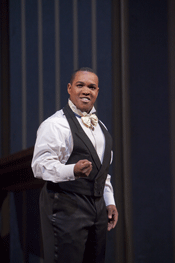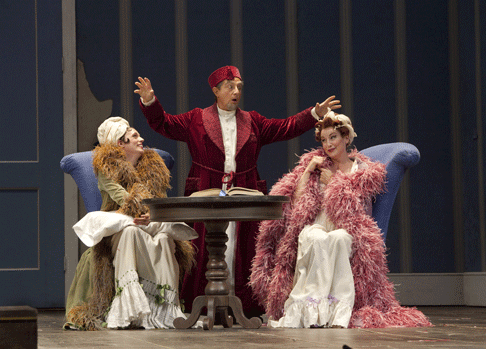21 Jun 2009
La Cenerentola at the MET
La Cenerentola runs third in popularity among Rossini’s comic operas — the Met didn’t get around to it at all until the present staging was created for Cecilia Bartoli.

La Cenerentola runs third in popularity among Rossini’s comic operas — the Met didn’t get around to it at all until the present staging was created for Cecilia Bartoli.
For the matter of that, they didn’t get around to L’Italiana in Algeri until the present production — the one Jean-Pierre Ponnelle was doing all over the operatic world — was created for Marilyn Horne, not so terribly long ago. Il Barbiere di Siviglia was the only Rossini opera buffa so far as New Yorkers (and most of the world) were concerned, from the very first season of the Met (in 1883) — actually from New York’s very first opera season, in 1829, when Garcia, the first Almaviva, brought his own company to town — until comparatively recent times. Il Turco in Italia ran one season at the City Opera; Il Viaggio a Reims and Le Comte Ory also played that innovative company with some success; Il Signor Bruschino has been given by the Gotham Chamber Opera; others — La Scala di Seta, L’Equivoco Stravagante, Il Cambiale di Matrimonio and so on, have had occasional or student or semi-amateur stagings hereabouts.
Cenerentola can seem long — they all can seem long — if the fun isn’t fresh and the singing less than grade A — but we live in an era of grade A Rossini singers, so there’s no excuse for that any more. It contains the usual Rossini elements: masks and mistaken identities, an orchestral storm, arias somewhat familiar from other Rossini operas, at least one aria for a minor character composed by someone else because Rossini was too busy (or lazy) (this is omitted in the Met production; it was given in the City Opera production), bravura singing for everybody, dueling comic basses, and two of Rossini’s famous wacky scene finales where Italiana and Barbiere only had one each. As is usual in dramatizations of the Cinderella legend, the stepsisters get a lot of farce time — which can be amusing at first, but wears out its welcome in time. Cenerentola ought to be more fun than it proved on this outing, and perhaps it was to those unfamiliar with the jokey Cesare Lievi/Maurizio Balò production, its garish palette, oversized rooms, and fantasy sequences.
 Lawrence Brownlee as Prince Ramiro
Lawrence Brownlee as Prince Ramiro
The comic basses were Simone Alberghini as Dandini, the prince’s
valet, masquerading as his master to distract Cinderella’s ghastly
family, and Alessandro Corbelli (this production’s original Dandini) now
promoted to Don Magnifico (Cinderella’s preposterous stepfather, a
snobbish, bankrupt aristocrat in the mold of the Duke of Plaza-Toro —
except the Duke is much nicer). They were the core of the evening’s fun,
stylish, absurd, graceful on the ear even when spluttering. The whole
buffa phenomenon was based on such figures and their highly personal
antics, not unlike the signature shtick of vaudeville comics — most
Italian opera houses in 1816 were small enough for any sort of nuance. Corbelli
and Alberghini are veterans who have made these sorts of roles their own.
Alberghini’s dancing prince-valet is so clearly out of musical comedy
that you wonder how anyone could fail to see he wasn’t a real prince
— except this is an opera buffa, and everyone is acting like that.
He’s just doing it better. Corbelli is a master of both the slow burn to
explosive payoff and the elegiac daydream (quoting the “voices” of
his fantasies) — he can even be romantic, as he showed in last
season’s Fille du Regiment. In contrast to this splendid buffo
fooling, the stepsisters in their mad 1920s getup rather wore out their
welcome, and the three-legged sofa is weary stuff.
One of the reasons Rossini’s operas have returned to popularity is that he wrote so many of his heroines for mezzo-sopranos, usually his lover (later wife) Isabella Colbran. The distinction was not made in Rossini’s lifetime — a soprano was a soprano; if she lacked top notes and had low notes, the composer wrote different music for her; if another singer came along, someone — not always the original composer — wrote her something new. (Sopranos often stole Rosina. Mezzos sometimes sang Rossini’s Otello.) We are living today in an age of wonderful light mezzos (one can trace the revival back to Horne, or to Simionato and Berganza if you prefer), and I believe we can all agree that they deserve more prima donna stage time than they tend to get.
 Rachelle Durkin as Clorinda, Alessandro Corbelli as Don Magnifico, Patricia Risley as Tisbe
Rachelle Durkin as Clorinda, Alessandro Corbelli as Don Magnifico, Patricia Risley as Tisbe
Cenerentola — or Angelina, as she is actually named — was sung this year by Elina Garanča, a Latvian mezzo who made her Met debut last year as Rosina. She is a beautiful woman with a beautiful voice — a combination still welcome but no longer uncommon on the opera stage. She looks good in anything, including — no, especially — trousers, as Bellini’s Roméo, and she has a sweet metallic sheen that easily fills the house. What she is not, on the evidence of this performance, is a Rossini coloratura of the Rossini buffa variety, capable of torrents of notes where other composers would settle for an attractive stream. When Rossini revs it, he really revs it. Garanča sings three notes for every five written in the racy cadenzas, and those cadenzas were composed to be sung five for five — as the performances of Simionato, Berganza, von Stade, Horne and Bartoli demonstrate. Therefore I am delighted that Garanča has joined the Met roster, but puzzled why she chose Rossini to do so — perhaps just to get her foot in the door, a worthy objective — and eager to hear her in more suitable repertory.
Another reason I was eager to attend this season’s Cenerentola was finally to hear Lawrence Brownlee, the young American contender in the Rossini tenor stakes and, by the sound of audience response, already a singer the Met has taken to its heart. Brownlee has, on the evidence, a larger, more liquid sound that Juan Diego Florez’s more nasal tone or Barry Banks’s more brilliant but less sensuous instrument, and he appears to be the equal of both in rapid-fire coloratura. Don Ramiro, the prince, is, alas, not much of a role — besides a couple of duets (with Angelina and Dandini) and parts in the concertati, he only has one bravura scene — I have always been surprised when a leading tenor like Florez or Vargas condescends to take it on. Brownlee seemed comfortable on stage in all the silliness required of Don Ramiro in this production, but he does not cut a terribly romantic figure beside the taller and slimmer Miss Garanča. I look forward to hearing him again this summer in the semi-staged operas being performed at Caramoor.
Maurizio Benini led a sprightly performance without the affectations that sometimes marred his conducting of Don Pasquale. The longueurs that crept in were often as not Rossini’s fault.
John Yohalem